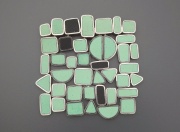Difference between revisions of "Rhodium"
m (Text replace - "== Authority ==" to "== Sources Checked for Data in Record ==") |
m (Text replace - "\[http:\/\/cameo\.mfa\.org\/materials\/fullrecord\.asp\?name=([^\s]+)\s(.*)\]" to "$2") |
||
| Line 2: | Line 2: | ||
== Description == | == Description == | ||
| − | A white, naturally occurring metallic element. Rhodium was discovered by William Wollaston in 1803. It is a very rare element belonging to the platinum group. Rhodium has an estimated concentration of 0.01 ppm in the earth's crust. It is extracted from platinum ores such as rhodite, sperrylite, and iridosmine. Metallic rhodium is used as an alloy with [ | + | A white, naturally occurring metallic element. Rhodium was discovered by William Wollaston in 1803. It is a very rare element belonging to the platinum group. Rhodium has an estimated concentration of 0.01 ppm in the earth's crust. It is extracted from platinum ores such as rhodite, sperrylite, and iridosmine. Metallic rhodium is used as an alloy with [[platinum|platinum]]. It is used as a nontarnishing plating finish for silverware and jewelry. Rhodium is also used for high-reflectivity mirror-surfaces on searchlights, optical instruments, and cinema projectors. |
== Synonyms and Related Terms == | == Synonyms and Related Terms == | ||
Revision as of 10:54, 10 May 2016
Description
A white, naturally occurring metallic element. Rhodium was discovered by William Wollaston in 1803. It is a very rare element belonging to the platinum group. Rhodium has an estimated concentration of 0.01 ppm in the earth's crust. It is extracted from platinum ores such as rhodite, sperrylite, and iridosmine. Metallic rhodium is used as an alloy with Platinum. It is used as a nontarnishing plating finish for silverware and jewelry. Rhodium is also used for high-reflectivity mirror-surfaces on searchlights, optical instruments, and cinema projectors.
Synonyms and Related Terms
Rh; rodio (It., Esp.); Ródio (Port.)
Other Properties
Soluble in fused potassium bisulfate. Insoluble in acids and aqua regia.
Face-centered cubic crystal.
| Composition | Rh (atomic no. 45) |
|---|---|
| CAS | 7440-16-6 |
| Mohs Hardness | 6.0 |
| Melting Point | 1966 |
| Density | 12.41 |
| Molecular Weight | atomic wt = 102.91 |
| Boiling Point | 3600-3825 |
Hazards and Safety
Powder is flammable.
LINK: International Chemical Safety Card
Additional Information
Web Elements: Website
Sources Checked for Data in Record
- G.S.Brady, Materials Handbook, McGraw-Hill Book Co., New York, 1971 Comment: p.668
- Richard S. Lewis, Hawley's Condensed Chemical Dictionary, Van Nostrand Reinhold, New York, 10th ed., 1993
- Van Nostrand's Scientific Encyclopedia, Douglas M. Considine (ed.), Van Nostrand Reinhold, New York, 1976
- Random House, Webster's Encyclopedic Unabridged Dictionary of the English Language, Grammercy Book, New York, 1997
- The Merck Index, Martha Windholz (ed.), Merck Research Labs, Rahway NJ, 10th edition, 1983 Comment: entry 8353
- The American Heritage Dictionary or Encarta, via Microsoft Bookshelf 98, Microsoft Corp., 1998
- Website address 1 Comment: Web Elements at http://www.webelements.com/webelements/elements/text/Rh/key.html gives discovery by William Hyde Wollaston, England, 1803
- Chemical & Engineering News, American Chemical Society, Washington DC, 81 (36) , Sept. 8, 2003 Comment: Jack Halpern, p. 114: discovered in 1803 by English chemist William H. Wollaston
